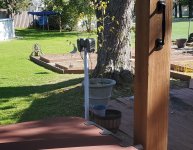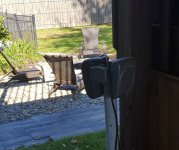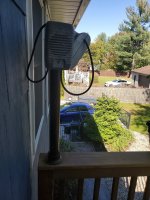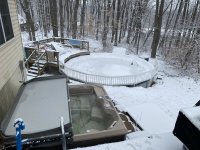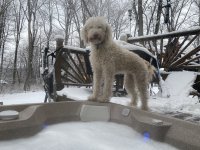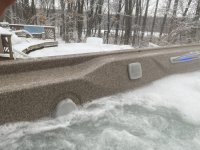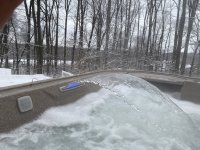I disagree with a lot of what you are saying about 24/7 circ pumps. The one on my Hot Spring runs 24/7/365 whether the heater is on or not. It is NOT less efficient from a system that uses a jet pump part time for circulating. It is, in fact, much more efficient.
Trying to make a large electric motor turn a high output pump at low rpms when they are not designed to do that and to make them constantly shut down and start up is highly inefficient and uses FAR more electricity running part time than running a small electric motor turning a low-flow pump full time. The new circ pump that Watkins is using only uses 35 Watts. That's only a little more Wattage than those tiny little incandescent bulbs they use or used in your refrigerator. It's dead silent and they last for years and years. As an engineer, I would never buy a hot tub that uses a large jet-pump as a part-time on-again / off-again circ pump. Large electric motors draw a TON of juice when starting up and still draw a lot when running, even when running at low rpm. That is a very poor and inefficient design IMO and if you do the math on it you will see that's true.
Personally, and as an engineer, I like Watkins Hot Springs tubs a lot because I think they are well designed/engineered. I know that getting parts for them can sometimes be expensive because they don't use standard off-the-shelf Balboa spa packs and their systems are unique to Watkins but the quality of their product is high. My tub is 27 years old and is working perfectly. Yes, I've had to replace the control system on it as well as a heater (the original one had the audacity to fail after 25 years) but the plumbing is 100% sound and I expect to be running that tub for years and years to come. I think that speaks pretty well to the quality and good design of the product.
Well, as an engineer, this intrigues me. I'm actually not certain how much more efficient it is. My two speed pump uses a (rated) 2.7 A at 240 V, or 648 watts. Considerably more power, but how much does it run?
First off, start up energy usage of a pump can effectively be neglected. There is a large current surge when a motor is started but only for an extremely brief period, like a couple seconds at best. So when you're talking about running a pump for minutes or more, it's effectively nothing.
Now, from a pump wattage perspective, things don't look good. If no heat is needed, the pump runs about 2 minutes every 20 minutes to circulate the water. That's 144 minutes a day, or 1600 Wh/day. This is almost double the 840 Wh/day a 35 watt pump would use running 24/7. So, it doesn't look great.
But the real question is...how much is wasted? Hot tubs need heat 24/7. Motors are 80-90% efficient. So 10-20% is wasted as heat in the motor. The rest of the energy? It all becomes heat in the hot tub. Basic thermodynamics. Energy in = energy out. All energy going into the motor has to go somewhere, so some is wasted as heat in the motor, but anything that gets put into the pump moves the water, which has friction, and ultimately all that energy ends up as heat. So if we say in both cases the motor is 80% efficient, and hot tubs always need heat, than the only wasted energy is that lost in heat in the motor, since 80% of the energy the motor is drawing is actually heating the water. So considering this, in my case I waste 320 Wh/day, and you waste 168 Wh/day. At my rates of $0.12/kWh, that's an extra $6/year. Not a lot at all.
However the issue is when you need heat, my pump needs to run on low speed the entire time the heater is on. I don't know how much this is. Say in winter my tub uses 500 kWh/month to heat. My low speed pump is adding that 520 watts of heat to the water, plus the 5.5 kW heater, so I need to run the pump an extra 83 hours a month for heating, or an extra 10.7 kWh/month, which is an extra $1.29/month at my electric rates. Not great, but certainly not terrible, and is dwarfed by the $60/month I'm spending in electricity per month. Really not something you'd notice on your electric bill, and this is worst case, winter month effect, so you wouldn't have an extra $1.29 every month.
Of course there's other factors in this if you are trying to consider all factors. By using the low speed pump, you are regularily mixing in the water in the pumps to the large pumps, which are uninsulated in the equipment bay, so each time the pump kicks on to check the water temp and circulate you loose a bit of heat from this. The 24/7 circ pump also will have some uninsulated sections, but presumably much less uninsulated pipe length and much smaller pipes, so overall less heat loss would be my guess. You'll have some extra bearing and pump seal wear on the two speed pump. You have other factors like my pump runs an extra few hours per day to run an ozone cycle, but it can heat during this so calculating this is a bit tricky. Not all spas have ozone, and my ozone is long broke and I want to disable the cycles entirely so the pump doesn't run, but I haven't bothered to figure out if that's possible yet.
In summary, yeah, it's less efficient, but compared to the massive energy usage of a spa in general, not
that much less efficient. In round numbers, it's like saying the 24/7 circ pump is twice as efficient, which it certainly is, but twice as efficient on 2% of the overall energy usage of the spa (again in worst case scenario, so ultimately it's not quite as big an effect to use a two speed jet pump for circulation and heating as it initially seems once you start considering all the factors.


